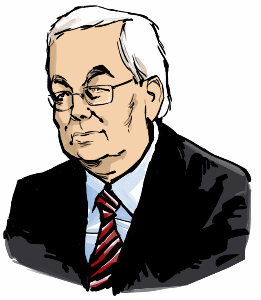© Gunnar Tómasson
1 March 2016
An Overview – Hamlet’s Mill
(Giorgio de Santillana)
This is meant to be only an essay. It is a first reconnaissance of a realm well-nigh unexplored and uncharted. From whichever way one enters it, one is caught in the same bewildering circular complexity, as in a labyrinth, for it has no deductive order in the abstract sense, but instead resembles an organism tightly closed in itself, or even better, a monumental „Art of the Fugue.“
The figure of Hamlet as a favorable starting point came by chance. Many other avenues offered themselves, rich in strange symbols and beckoning with great images, but the choice went to Hamlet because he led the mind on a truly inductive quest through a familiar landscape – and one which has the merit of its literary setting. Here is a character deeply present to our awareness, in whom ambiguities and uncertainties, tormented self-questioning and dispassionate insight give a presentiment of the modern mind. His personal drama was that he had to be a hero, but still try to avoid the role Destiny assigned him. His lucid intellect remained above the conflict of motives – in other words, his was and is a truly contemporary consciousness. And yet this character whom the poet made one of us, the first unhappy intellectual, concealed a past as a legendary being, his features predetermined, preshaped by long-standing myth. There was a numinous aura around him, and many clues led up to him. But it was a surprise to find behind the mask an ancient and all-embracing cosmic power – the original master of the dreamed-of first age of the world.
Yet in all his guises he remained strangely himself. The original Amlóði, as his name was in Icelandic legend, shows the same characteristics of melancholy and high intellect. He, too, is a son dedicated to avenge his father, a speaker of cryptic but inescapable truths, an elusive carrier of Fate who must yield once his mission is accomplished and sink once more into concealment in the depths of time to which he belongs: Lord of the Golden Age, the Once and Future King.
This essay will follow the figure farther and farther afield, from the Northland to Rome, from there to Finland, Iran, and India; he will appear again unmistakably in Polynesian legend. Many other Dominions and Powers will materialize to frame him within the proper order.
Amlóði was identified, in the crude and vivid imagery of the Norse, by the ownership of a fabled mill which, in his own time, ground out peace and plenty. Later, in decaying times, it ground out salt; and now finally, having landed at the bottom of the sea, it is grinding rock and sand, creating a vast whirlpool, the Maelstrom (i.e. the grinding stream, from the [Icelandic] verb mala, „to grind“), which is supposed to be a way to the land of the dead. This imagery stands, as the evidence develops, for an astronomical process, the secular shifting of the sun through the signs of the zodiac which determines world-ages, each numbering thousands of years. Each age brings a World Era, a Twilight of the Gods. Great structures collapse; pillars topple which supported the great fabric; floods and cataclysms herald the shaping of a new world. (Hamlet’s Mill – An Essay on Myth and the Frame of Time, 1969; Second Paperback Edition, David R. Godine, Publisher, Boston, 1983, pp. 1-2.)
Hamlet’s Mill – Reception by scholars
(Wikipedia)
Hamlet’s Mill was severely criticized by academic reviewers on a number of grounds: tenuous arguments based on incorrect or outdated linguistic information; lack of familiarity with modern sources; an over-reliance on coincidence or analogy; and the general implausibility of a far-flung and influential civilization existing and not leaving behind solid evidence. At most, it has been given a grudging sort of praise. Thus, Jaan Puhvel (1970) concluded that
„This is not a serious scholarly work on the problem of myth in the closing decades of the twentieth century. There are frequent flashes of insight, for example, on the cyclical world views of the ancients and on the nature of mythical language, as well as genuinely eloquent, quasi-poetic homilies.“
Writing in The New York Review of Books, Edmund Leach noted:
“[The] authors’ insistence that between about 4000 B.C. and 100 A.D. a single archaic system prevailed throughout most of the civilized and proto-civilized world is pure fantasy. Their attempt to delineate the details of this system by a worldwide scatter of random oddments of mythology is no more than an intellectual game. […] Something like 60 percent of the text is made up of complex arguments about Indo-European etymologies which would have seemed old-fashioned as early as 1870.”
R. Ellis Davidson referred to Hamlet’s Mill as
„amateurish in the worst sense, jumping to wild conclusions without any knowledge of the historical value of the sources or of previous work done. On the Scandinavian side there is heavy dependence on the fantasies of Rydberg, writing in the last [19th] century, and apparent ignorance of progress made since his time.“
In contrast the classical scholar Harald Reiche positively reviewed Hamlet’s Mill. However Reiche was a colleague of Santillana at MIT, and himself developed the archaeoastronomical interpretation of ancient myth in a series of lectures and publications similar to Hamlet’s Mill (dealing more specifically with Greek mythology), including an interpretation of „the layout of Atlantis as a sort of map of the sky“.
Barber & Barber (2006), itself a study aiming to „uncover seismic, geological, astrological, or other natural events“ from mythology, appreciates the book for its pioneer work in mythography, judging that „Although controversial, [Santillana and von Dechend] have usefully flagged and collected Herculean amounts of relevant data.“ Nevertheless, the conclusions the authors draw from their data have been „virtually ignored by the scientific and scholarly establishment.”
Augustan-Saga-Shakespeare Myth
Hamlet’s Revenge
As will be outlined further in two follow-up notes, the encounter between Prince Hamlet with the Ghost of his Father in Act I, Sc. v of the play in the First folio of 1623,, where the Prince swears to avenge his Father‘s murder, has a Cipher Value of 1658168, as in 262982 + 552503 + 777077 + 65613 – 7 = 1658168.
The first three components are the Cipher Values of (i) the Myth‘s foundational text known as Horace‘s Monument, (ii) its universal scope conveyed in terms of men slain or fatally wounded at Armageddon as recreated in an account by Saga Author Sturla Þórðarson (d. 1284), and (iii) its application at the level of individuals as represented by a 13th century account of Sturla Þórðarson’s final years and death.
Prince Hamlet is archetypal Hebrew Man of Seventh Day, whose death (-7) represents at once fulfilment of Hamlet‘s oath of revenge and the core psychological aspect of the drama, namely, the overcoming by Prince Hamlet of himself. Essential aspects of Pythagorean Creation Myth are reflected in 65613, which is the Cipher Value of Prince Hamlet‘s words immediately after exit of the Ghost of his Father:
18729 = Oh all you host of heauen! Oh Earth; what els?
15857 = And shall I couple Hell? Oh fie: hold my heart
21200 = And you my sinnewes, grow not instant Old;
9827 = But beare me stiffely yp.
65613
***
Calculator for converting letters to cipher values is at:
http://www.light-of-truth.com/ciphersaga.htm

 Gunnar Tómasson
Gunnar Tómasson